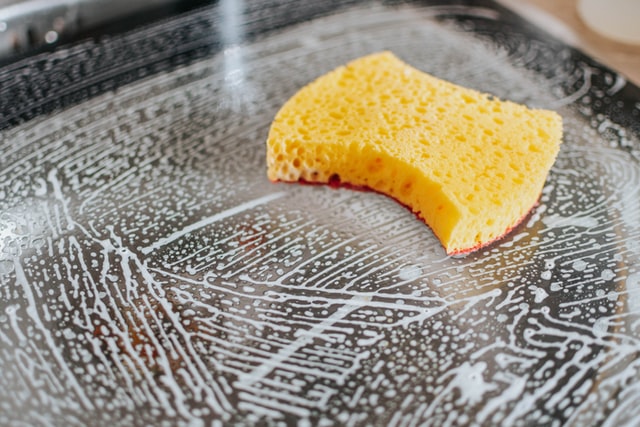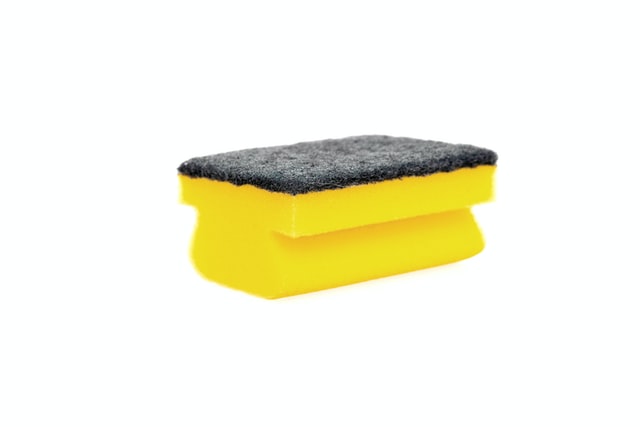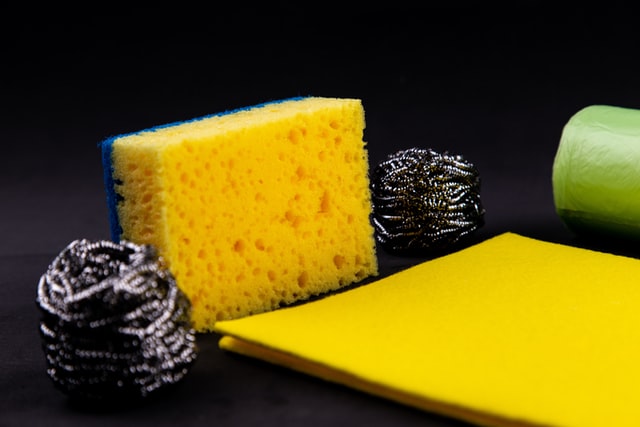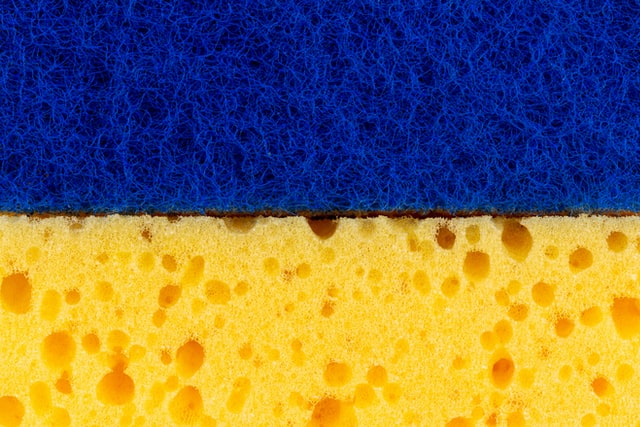A kitchen sponge is a popular cleaning item. It absorbs a lot of filth and leaves your kitchen shining, from your dishes to your surfaces. As a result, it should come as no wonder that the kitchen sponge is teeming with bacteria. E Coli and salmonella are just two of the nasty germs that may develop in kitchen sponges, and an unpleasant odor is a sign that your sponge is harboring a slew of hazardous microbes. A musty, mildew-sprouting stench indicates that the sponge should be replaced or cleaned.
While sponges will always be a breeding place for germs, there are several things you can do to keep them as clean as possible.
Great Methods for Preventing the Odor of your Kitchen Sponge

➖ Microwave
You can microwave the kitchen sponge to eliminate more than 99 percent of the odor-causing bacteria. Microwave a moist sponge on high for 1 to 2 minutes to kill quickly colonizing bacteria, molds, and yeast.
Avoid using a dry sponge in the microwave because it may catch fire, and avoid using any sponge with metallic fibers for cleaning in the microwave. After you’ve microwaved the sponge to destroy the germs, let it cool before extracting it to avoid burning your hand.
➖ Dishwasher
When your sponge smells nasty, you may wash it in the dishwasher. Place it in the dishwasher with your dirty dishes for the whole cycle, wedging it tightly on the top shelf so it remains put while it’s cleaned, rinsed, and blasted with heat to dry.
The water must also be appropriately heated. Germs in your sponge will be killed by water that is 140 degrees Fahrenheit or higher. Keep two kitchen sponges on hand and alternate them in and out of the dishwasher to ensure that you always have a clean sponge on hand.
➖ Disinfectant
Green cleaning is effective for sponges and provides peace of mind when used on dishes. To deter the nasties that can do terrible things to you, soak your kitchen sponge at the first faint odor of discomfort, ideally even before things get to that stage.
To destroy germs, mold, yeast, and viruses, soak the whole sponge in full-strength white vinegar or lemon juice. This does not eliminate all of the harmful germs as effectively as a microwave blast, but it does eliminate a significant percentage of the bacteria. Alternatively, immerse the sponge in a solution of 1/2 teaspoon bleach in 1-quart warm water for one minute.
➖ Dry it Out
Bacteria and viruses require warm, moist conditions to colonize your sponge, so keeping it in the sink might encourage the growth of bacteria and odors. Allow it to dry between usage to reduce the number of undesired lifeforms.
Store the sponge in an open basket suspended over the sink, or try this DIY method to enable air to reach all sponge surfaces. Pinch one short end of the sponge in a binder clip and set the clip on its metal handles to retain the sponge out of the water and dry rapidly.
Drying sponges between usage is difficult in humid circumstances. In humid climates, dishwasher or microwave sessions should be used to augment between-use drying measures. Replace kitchen sponges regularly, at the first indication of degradation or when the odor cannot be entirely removed.
How to Wash a Kitchen Sponge

Sponges are designed to keep kitchens and bathrooms clean, but they may potentially transmit deadly bacteria.
And because they frequently do not dry out between usage, the damp, heated atmosphere is ideal for bacteria to proliferate. You can increase the life of a sponge by cleaning it regularly.
● By Bleach
Bleach is a strong disinfectant that is extremely good in killing microorganisms on sponges. Just keep in mind that it must be diluted with water before use. Blend 1 to 3 teaspoons bleach with 1 quart of water to produce a disinfecting solution.
Fill a bucket with 1/4- to 3/4-cup bleach and 1 gallon of water if you’re washing a few sponges or adding other objects to the cleaning bath.
Immerse the sponge for at least five minutes before rinsing it. Allow the sponge to dry on its own.
● By Vinegar
If you do not want to use bleach, soak in undiluted distilled white vinegar instead. Vinegar’s acetic acid successfully kills 99.6 percent of germs on sponges.
Dampen sponges for at least five minutes and up to an hour. Squeeze the vinegar out of the sponge, rinse it, then air dry it.
Various Types of Kitchen Sponges

Kitchen sponges are not one size fits all. Since there is a surprisingly big variety of sponges available for cleaning chores, each with its own unique qualities.
➣ Rubber Sponges
Rubber sponges are made of rubber, as one could expect from the name. It may be used to clean surfaces that do not need to be wet.
Dry sponges are another name for them. Before wiping clean your surfaces, moisten the sponge, and apply a little amount of liquid soap.
➣ Cellulose Sponges
Cellulose sponges are the most commonly found sponges on the market. They are quite useful and reasonably priced.
They are extremely porous and may trap water. It can contain a lot of food. These sponges are difficult to clean and serve as a breeding base for germs.
➣ Microfiber Sponges
Microfiber sponges may be used on any type of dish. It is suitable on any surface. Microfiber is a soft sponge that never hardens.
Despite its softness, it successfully eliminates all food, even stuck-on food, from your plates. It dries fast, giving germs little time to grow.
➣ Non-Scratch Scrub Brushes
Scrubbers and sponges are combined in Non-Scratch Scrub Brushes. They normally feature a cellulose sponge on one side and a scrubber on the other. They are strong enough to remove stuck-on food yet gentle enough not to scratch your pots and pans.
The soft side is ideal for cleaning your most fragile glasses. The scrubber side of the brush may have lines on it at times. These lines keep food from sticking to the sponge. They also aid in the elimination of odor. These sponges may be cleaned in the dishwasher, but they must be replaced daily.
➣ Sponge Dish Wand
A dish wand sponge is a sort of combination product. This dish sponge’s handle contains dishwashing soap. This handle avoids the need for you to muck around with dishwashing soap when washing dishes.
This dish wand sponge aids in the cleanliness of your kitchen sink. These dish wand sponges are available with two brush heads: a nylon brush and a foam sponge.
These heads are changeable and may be purchased at your local hardware shop. These replacements are also available online. You may also swap them out depending on your current needs.
The wand sponge has a base closure where you may load it with dish cleaning soap. It includes a button that you must press for the soap to come out and wash the dishes. When not in use, place this wand vertical in a drying rack to prevent soap from leaking out.
➣ Foam Sponge
Varying on your demands, the foam sponge can be soft or have a scrubber. This is also the most commonly used sponge in every kitchen.
It features a hard side that may be used to remove the tougher areas on your plates. The soft side is used to remove all food particles.
➣ Silicone Sponge
Since silicone sponges are not porous, they do not retain bacteria or odor. And because they lack germs, they will not stink like a cellulose sponge. If you’ve ever noticed a bad odor coming from your sponge, you won’t have to worry about that with this sort of sponge.
These sponges are made of food-grade silicone. These sponges are excellent for cleaning food particles from your dishes, especially pots and pans. They may also be used as a potholder if you need to touch a hot dish.
A silicone sponge may also be used to scrub vegetables. They may be cleaned in the dishwasher and dry rapidly. When cleaning dishes, a silicone sponge may be slick and slide out of your grasp.
➣ Stainless Steel Sponge
Stainless steel sponges are ideal for cleaning pots and pans with rigid cores that have been clogged with food. These dishes need a lot of effort to clear the food off the dishes. These are constructed of 410 stainless steel. The stainless steel is tightly coiled and knitted together to form a sponge.
These sponges are not particularly large, but they are round in form. Due to the obvious round design, it is ergonomically pleasant and comfortable to grasp in your hand. They are adaptable and easy to use. It may be used for more than just removing food from pots and pans. It may also be utilized on tools and in ovens.
What you Should Know About your Kitchen Sponge

One of the most critical items in your everyday domestic routine may be causing you more harm than you realize.
⊕ The Material
Using a sponge made of Polyurethane foam – generally bright yellow with a coating of plastic scourer attached – is hazardous to the environment since they do not degrade in waste once discarded.
It’s ironic because they don’t stay long in usable condition before they need to be replaced. A cellulose sponge, which is constructed from natural plant or wood fibers, is a superior choice since it is typically more resilient than the polyurethane version and decomposes more easily as trash.
It’s vital to note that even fabric-type cleaning cloths contain small microplastics, which have been shown to penetrate not just the seafood we consume but also our own bodies, according to new research.
⊕ It Aids in the Transmission of Germs
To prevent the formation of bacteria inside its various fibers and layers, your kitchen sponge should be cleaned on a frequent and thorough basis.
Throughout the day, it will take up and disperse germs and bacteria to all of your kitchen tops, bins, and fridge doors.
⊕ How Frequently you should Cleanse it
Since your kitchen is more prone to harbor bacteria than your bathroom, maintaining things clean in the kitchen is a full-time task, and your sponge is one of the biggest offenders.
Thorough cleaning with a deep soak is advised daily.
⊕ Cleaning it
Think again if you believe that zapping your sponge in the microwave or pouring a gallon of boiling water over it would destroy the bacteria hiding in its dark depths.
Cleaning it properly can lower the level of germs in your sponge by up to 60% but cannot completely eradicate it. To further diminish the prevalence of germs, experts suggest soaking in a bleach mixture.
⊕ Replacing it
The suggested frequency is once a week, but once a month on the exterior. This is where things get tough since it may get pricey – especially if you’re buying in cellulose sponges with the environment in sense.
Alternatively, consider changing to a more environmentally friendly alternative.
Reasons why Filthy Kitchen Sponges are Dangerous

A kitchen sponge, often known as a sponge, can cause a variety of illnesses in your body. This is because they are always drenched in water and are frequently used while cleaning your dishes after meals or snack time.
When a person fails to wash their hands after cleaning their dishes, they are prone to contract an illness from the kitchen sponge without even realizing it. Some condemn it on the food they eat, but it is their good hygiene habits after utilizing the sponge that is to blame.
❕ It is Always Wet
It is critical to understand that infections prefer wetness since it allows them to live longer. This implies that pathogens, such as dangerous bacteria, can attach themselves to unwary hosts for several days or even weeks.
And because they are primarily utilized as a dishwashing cleaner for kitchen items, kitchen sponges are usually wet. They may also be used instead of a brush to clean any surface.
❕ It has many Holes
When you look closely, you may see thousands of holes or compartments in your sponge. Pathogens like anything that give a large enough space for them to hide and persist for extended periods before infecting their victims.
Essentially, the sponge may provide a haven for washed-away viruses, allowing them to grow and return to any host that can handle or come into touch with the kitchen sponge at any moment.
❕ Germs Grow Faster
A virus, for example, would likely proliferate quicker than predicted if placed within a sponge. The reason for this is that the environment is moist and constantly lived with a new set of germs, resulting in a chain reaction.
Even if only one disease, such as a virus or bacteria, enters the sponge, it will reproduce in just hours after being shielded by an item that provides a pleasant habitat for it to evolve and grow exponentially.
❕ It Attracts Molds
Even if you leave the kitchen unattended for a day, you will not realize that another infection is growing. It’s the molds this time. Fungi also prefer a damp environment in which to flourish.
You will see that many colorful dots develop in some regions of the kitchen sponge. These are particularly infectious agents because they can cause brain inflammation once they enter your bloodstream.
❕ Destroys your Nails
If you do not practice adequate cleanliness after utilizing the sponge, pathogens will be dislodged inside your nailbeds, creating germ collection.
As the bacteria proliferate, your nail becomes irritated. A fungus is to blame if your nails begin to deteriorate with the finger. When pus forms under the nails, there is a bacterial infection.
❕ It can Cause Poisoning
Normally, plates, glasses, and other kitchen items should be cleaned using a sponge. However, any unremoved food particles pose a substantial risk to the health of anyone who uses them straight to their lips.
Any food particles that linger in the utensils might lead to bacterial infection and food poisoning. This is risky since it can result in diarrhea, dehydration, and death.
❕ It Can Cause Skin Infection
If kitchen sponges come into touch with any open wounds, they might cause skin infections. Water droplets are already infected, so when they are dropped on an open wound, they add new harmful germs that cause illness.
❕ It can make your Kitchen Smell
A filthy kitchen sponge is teeming with microorganisms and creates an unpleasant odor. If you’re wondering why your kitchen smells so bad, blame it on your unclean sponge that hasn’t been replaced in weeks.
Frequently Asked Questions
Q: Why is it that my sponge constantly stinks?
A: As the food particles dissolve, the sponge starts to sour and stink.
Q: How can I improve the odor of my kitchen sponge?
A: Dousing your sponge in bleach is the most efficient and simple way to clean it. Soak it for at least five minutes in a solution of 3/4 cup bleach to 1 gallon of water before squeezing and rinsing it.
Q: Is it possible to disinfect a sponge by boiling it?
A: Regularly cleaning sponges in the microwave or boiling them in water does not render them germ-free.
Q: When should you replace your kitchen sponge?
A: A kitchen sponge should be replaced at least once a week as a general rule.
Q: Is it possible to wash a sponge in the washing machine?
A: Simply place sponges in your washing machine or dishwasher’s HOT cycle and let the machine do the rest.
Final Thoughts
Sponges may become a breeding ground for bacteria if not cleaned correctly and regularly. If you truly like sponges but want something healthy, you may try a microfiber sponge. This sponge dries quickly, giving germs less time to develop and flourish. If you enjoy sponges but want to try something new, silicone sponges are an option.
To avoid harmful circumstances in the future, it is critical to clean and replace your sponges regularly.
